Sustainable Living: The Future of Dubai's Homes
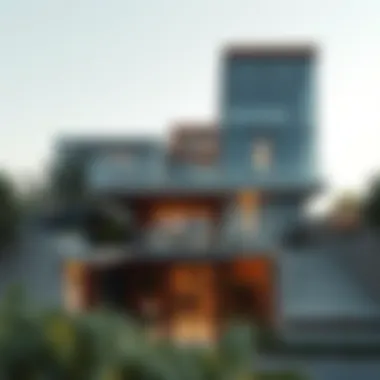
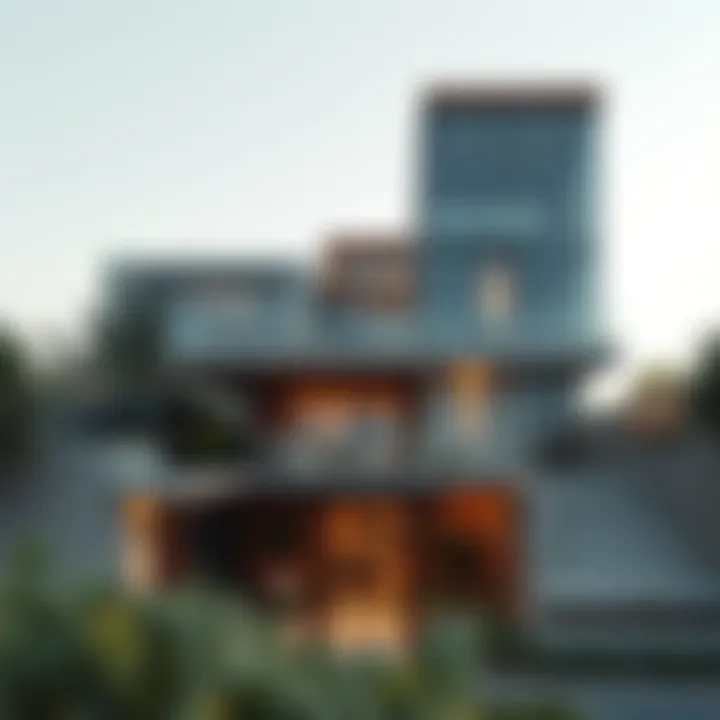
Intro
The shift towards sustainable housing isn’t just a fleeting trend; it reflects a fundamental change in how we approach living spaces, notably in a city like Dubai, which is often seen as a hub of luxury and avant-garde design. In recent years, Dubai has positioned itself at the forefront of this movement, weaving sustainability into the very fabric of its real estate market. This is not merely about being eco-friendly; it encompasses thoughtful architectural design, energy efficiency, and the creation of communities that nurture social well-being.
As the world grapples with the implications of climate change, the demand for sustainable houses has surged. Investors, homebuyers, and urban planners alike are increasingly aware that sustainable practices not only contribute to environmental wellness but also enhance property value and societal health. The article at hand dives into various facets of sustainable housing in Dubai, shedding light on the intricate details of architectural choices, the push for energy-efficient solutions, and the local government’s active role in promoting green initiatives.
Understanding these aspects is crucial for those seeking opportunities in the real estate market, as the emphasis on sustainability reshapes the landscape, presenting unique prospects for investment and living.
Thus, as we unfold the narrative of sustainable houses in Dubai, let’s first step into the current dynamics of the market.
Understanding Sustainable Housing
Sustainable housing has become a cornerstone of contemporary architecture and urban planning, particularly in environments as dynamic as Dubai. As the emirate grapples with rapid urban development and environmental challenges, the significance of sustainable living practices has gained heightened relevance. For investors, homebuyers, and real estate agents, realizing the implications of sustainability can lead to informed decisions that go beyond mere aesthetics; it revolves around long-term viability and community well-being.
Definition and Importance
At its core, sustainable housing refers to residential structures designed to minimize environmental impact while maximizing energy efficiency and resource conservation. This approach not only reduces the overall carbon footprint but also fosters a healthier living environment, which can translate into economic benefits. Homebuyers today are increasingly looking for homes that embody these values.
The advantages of sustainable homes include:
- Cost Savings: Efficient energy use leads to lower utility bills over time.
- Higher Property Values: Investment in sustainable homes often yields better returns as they become more desirable in the real estate market.
- Health Benefits: Improved air quality and natural light contribute positively to the health and well-being of residents.
- Community Impact: Sustainable housing can foster a sense of community and responsibility towards the environment, creating bonds among neighbors who share similar values.
It is essential for stakeholders to understand that embracing sustainable housing is not merely a trend but a crucial move towards creating future-ready urban landscapes. As the saying goes, "A penny saved is a penny earned,” and in the case of sustainable living, the savings are manifold, encompassing financial, environmental, and social realms.
Historical Context
To grasp the current landscape of sustainable housing, we must glimpse into the progression of architectural practices and urban solutions over the decades. Traditionally, many structures in Dubai were constructed with little consideration for sustainability, heavily relying on energy-intensive cooling systems amidst the harsh desert climate.
However, as global awareness of climate change escalated, so did calls for environmentally-conscious building practices. The 2008 financial crisis served as a wake-up call, pushing developers and regulations to pivot towards more sustainable methods. Initiatives such as the Dubai Clean Energy Strategy 2050 highlight the emirate's commitment to sustainability, aiming at producing 75% of its energy output from sources other than fossil fuels.
In recent years, the rise of sustainable housing developments has been supported by regulatory frameworks encouraging green architecture. Notable examples include the plans for Zero Energy Buildings and LEED-certified projects, which mark a shift from mere compliance to innovation. This historical evolution underlines that sustainable housing is not a fleeting notion. Instead, it represents a foundational aspect of Dubai's commitment to environmental stewardship and resilient urban growth.
"The future will not be about what you own, but about how sustainable your lifestyle is."
The Key Components of Sustainable Houses
Sustainable houses are not simply abodes; they represent a philosophy and a commitment to coexist with our environment. In Dubai's real estate landscape, where urban development is often rapid and extensive, understanding the key components of sustainable houses is critical. These components do more than just meet ecological standards; they are investments in our future.
The major features of sustainable houses include eco-friendly materials, energy efficiency, water conservation techniques, and land use optimization. Each of these elements has its unique benefits, and together they shape the narrative of sustainable living in Dubai.
Eco-friendly Materials
Using eco-friendly materials in construction goes beyond doing what’s right for the planet; it can significantly affect occupant health and overall building performance. Materials like bamboo, recycled steel, and reclaimed wood are lauded for their lower environmental impact. Not just that, these materials come with benefits like hardness and longevity.
Choosing materials that are sustainably sourced not only minimizes carbon footprints but can also improve thermal insulation, thereby contributing to energy efficiency. In arid environments like Dubai, the choice of breathable materials can aid ventilation, keeping homes naturally cool.
Energy Efficiency
Energy efficiency in homes serves both environmental and financial purposes. With the soaring temperatures in Dubai, investing in energy-efficient technologies like solar panels and high-performance HVAC systems can significantly reduce energy consumption. These measures not only lower utility bills but can attract the environmentally conscious buyers.
A significant aspect of energy efficiency is proper insulation. A well-insulated home reduces the demand on cooling systems, leading to lower energy usage. Homeowners can employ techniques such as reflective roof materials, which reduce heat absorption, further contributing to energy savings.
Water Conservation Techniques
Water scarcity is a pressing issue in desert regions, making water conservation techniques indispensable in sustainable housing. Systems like rainwater harvesting and greywater recycling promote responsible water use. Just think of it—collecting rainwater for irrigation or toilet flushing can drastically cut down water bills.
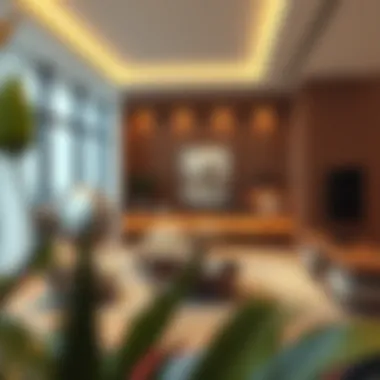
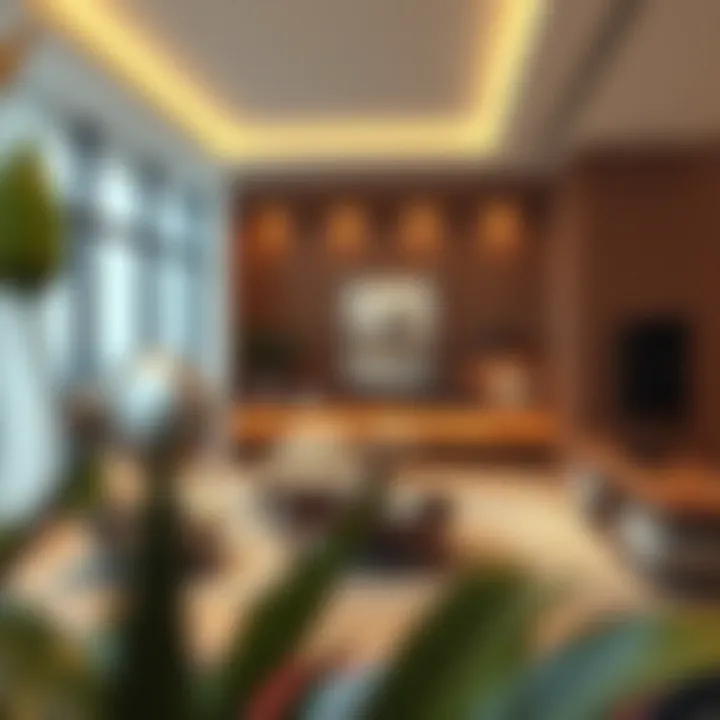
Moreover, the use of drought-resistant landscaping, known as xeriscaping, doesn't just look good but also limits the need for extensive irrigation. It's about making smart choices that balance arid conditions while fostering a lush living environment.
Land Use Optimization
Land use optimization is tailored to maximize the efficiency of the land while minimizing ecological footprints. In Dubai, where space can be a premium, innovative designs that respect the local environment can blend living and recreational spaces effectively.
Design choices like mixed-use developments not only create vibrant communities but can reduce reliance on vehicles, thus cutting down pollution. Thoughtful planning of green spaces within residential complexes encourages community interaction, fostering a strong sense of belonging.
"The future of urbanization depends on balancing community needs with the responsibilities we hold towards our environment."
In summary, each of these key components plays a significant role in creating sustainable houses. By adopting these practices, homeowners contribute to the broader movement of sustainability that is transforming Dubai's real estate industry, making it essential for investors, homebuyers, and analysts to be well-informed about these elements.
Sustainable House Designs
Sustainable house designs play a pivotal role in shaping the architecture of Dubai's residential environment. Such designs not only focus on minimizing environmental impact but also maximize the quality of life for its residents. A thoughtful approach to sustainable design can lead to substantial reductions in resource consumption, lower energy bills, and improved overall comfort. Investors and homebuyers are increasingly recognizing the value in such properties, understanding that sustainability is becoming synonymous with modern living.
Passive Solar Design
Passive solar design harnesses the sun’s energy without reliance on mechanical systems. It involves strategic architectural positioning, window placement, and thermal mass materials to either absorb or reflect sunlight. Homes that incorporate this concept can significantly reduce utility bills and enhance indoor comfort. For instance, a south-facing window will allow for ample sunlight during winter, while shading devices or trees can block intense rays during the summer months.
- Advantages
- Reduces dependence on artificial heating and cooling systems.
- Increases comfort by maintaining a stable indoor temperature.
- Promotes renewable resources by utilizing the sun's energy directly.
Investors looking at properties designed with passive solar principles often find their investments appreciating in value. Energy efficiency translates to lower operational costs, which is attractive in today’s market.
Green Roofs and Vertical Gardens
Green roofs and vertical gardens are transforming urban landscapes, allowing homeowners to cultivate nature while maximizing space. These designs not only enhance aesthetic value but also contribute to biodiversity, air quality improvement, and urban cooling. A green roof can effectively insulate a building, reducing the need for HVAC systems. Vertical gardens, often seen on building facades, create a micro-habitat, improving the environment for local flora and fauna.
- Benefits of Green Roofs
- Insulation helps in energy conservation.
- Reduces stormwater runoff, helping in flood prevention.
- Can produce food, adding an element of self-sufficiency.
These designs also align with the growing desire for sustainability among residents. A home that incorporates nature not only stands out but also reflects a commitment to ecological responsibility.
Modular and Prefabricated Construction
Modular and prefabricated construction methods are gradually gaining traction in Dubai’s real estate landscape. These techniques allow for quicker build times and reduced waste. In modular construction, sections of a home are built off-site and transported for assembly, minimizing environmental disruption.
- Advantages
- Efficient use of materials leads to reduced waste.
- Shorter construction timelines can lower labor costs.
- High-quality control as components are produced in a factory setting.
From an investment viewpoint, modular homes can represent a smart choice. They often carry lower long-term operational costs, especially if they incorporate energy-efficient features. As sustainability trends continue to expand, the demand for such innovative designs is expected to rise.
"Sustainable house designs are no longer just an option; they are becoming a necessity in today's rapidly changing real estate market."
Regulatory Framework in Dubai
The regulatory framework governing sustainable housing in Dubai plays a significant role in shaping the real estate landscape. With rapid urban growth and a fierce commitment to sustainability, Dubai has implemented various regulations and initiatives that not only support sustainable practices but also encourage developers and investors alike to embrace eco-friendly designs.
Government Incentives
The government of Dubai, understanding the need for sustainable development, has rolled out a suite of incentives aimed at promoting green construction. These incentives are pivotal for both developers and homeowners. For instance, owners of sustainable houses can benefit from reduced utility bills due to energy-efficient installations. Furthermore, developers who incorporate sustainable features may receive financial grants or tax breaks, making it an attractive choice to prioritize sustainability.
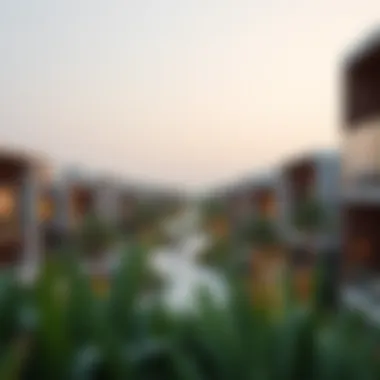
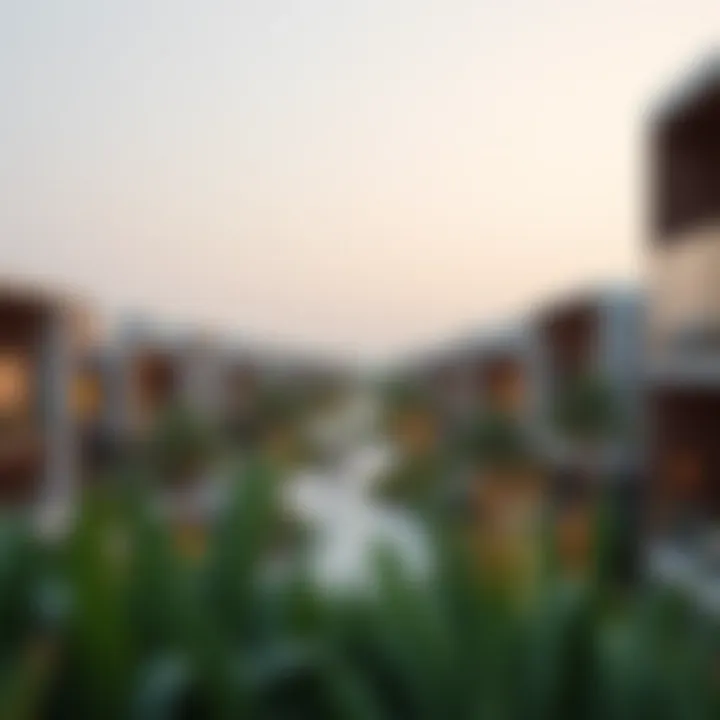
Other incentives include streamlined permitting processes and reduced fees for projects that meet certain green standards. This can make a world of difference; getting approvals often feels like pulling teeth, but a clear incentive can speed things along. In short, the government is all in when it comes to making sustainable housing a win-win for everyone involved.
Building Codes and Standards
Building codes and standards in Dubai are designed to support the implementation of sustainable housing practices. Various regulations outline the essential requirements for energy efficiency, water conservation, and the use of eco-friendly materials. These codes ensure that new developments don’t just tick boxes but genuinely contribute to a sustainable future.
Moreover, Dubai’s building standards evolve regularly, keeping pace with advancements in sustainable technology. This adaptability shows a commitment to not just preserve the environment but to innovate for future generations. Adhering to these standards can not only enhance property value but also appeal to an increasingly eco-conscious buyer base.
"A house is made of bricks and beams, but a home is made of hopes and dreams." - Unknown
The Role of Technology in Sustainable Homes
In the ever-evolving sphere of real estate, technology stands as a pivotal force behind the shift toward sustainable homes. The incorporation of advanced technological solutions not only enhances the efficiency of residential spaces but also supports efforts to reduce the ecological footprint. This connection between technology and sustainability is not merely an afterthought; rather, it encompasses a responsible approach to modern living, emphasizing comfort and environmental stewardship. As we explore the role of technology in sustainable homes, it will become evident how these innovative elements not only transform how individuals interact with their dwellings but also contribute to the broader objectives of sustainability.
Smart Home Integration
Smart homes are often touted as the vanguards of modern living. These homes utilize intelligent technologies to optimize efficiency, convenience, and sustainability. By integrating smart devices, residents can manage energy consumption in real time, ensuring that resources are used judiciously.
Key aspects of smart home integration include:
- Automated Systems: Homeowners can use smart thermostats, like the Nest or Ecobee, enabling them to regulate heating and cooling based on occupancy and time of day. This not only reduces utility costs but also minimizes energy waste.
- Lighting Control: Smart lighting systems allow for adjustable brightness and programmed schedules. Such features ensure that lights are only on when needed, which further cuts down on unnecessary energy expenditure.
- Connected Appliances: The advent of Internet of Things (IoT) appliances, such as smart refrigerators and washing machines, empower users to receive updates and control these devices from their smartphones. This aspect of management encourages more efficient use of water and energy.
- Monitoring Systems: Sensors that track energy use, water consumption, and atmospheric conditions help homeowners identify inefficiencies. This data can be critical in making informed decisions about how to enhance the sustainability profile of a home.
"Harnessing technology within housing means transforming the way we engage with our living environments."
Renewable Energy Solutions
Embracing renewable energy technologies is another cornerstone in the journey toward sustainable living. In Dubai's sunny climate, solar energy systems have gained significant traction. The ability to harness the sun’s energy not only lessens dependence on fossil fuels but can also lead to substantial cost savings over time.
Core renewable solutions in sustainable homes include:
- Solar Panels: Installing photovoltaic panels provides homeowners with a renewable source of electricity. Excess energy generated can often be fed back into the grid through net metering, presenting an additional financial incentive.
- Solar Water Heaters: These systems utilize solar energy to heat water, reducing reliance on conventional heating methods. This innovation can lower energy bills significantly, especially in regions with ample sunlight.
- Wind Turbines: While not as common in all residential areas, small wind turbines can supplement energy needs. For properties in windy locales, this can be a valuable addition to a sustainable home’s energy arsenal.
- Energy Storage Systems: Technologies such as home battery systems, like the Tesla Powerwall, provide the ability to store excess energy generated. This stored energy can be critical during power outages or peak usage times, allowing homeowners to utilize their renewable energy effectively.
By integrating these technologies, homeowners not only contribute to a more sustainable environment but also enhance their living experience, melded seamlessly with the advantages of modern convenience and long-term economic benefits. In a city that continues to grow and innovate, embracing these technologies is a prudent step toward a greener future.
Market Trends and Analysis
Understanding the market trends and analysis of sustainable housing in Dubai is essential for various stakeholders, including investors, homebuyers, and real estate analysts. Not only does it help in setting expectations regarding property values, but it also clarifies the evolving landscape of residential living in the region. In a city that’s constantly redefining luxury and progress, the inclusion of sustainability into its real estate narrative paints a compelling picture of the future. Emerging trends reflect a mix of technological integration and a shift towards eco-conscious living.
Demand for Sustainable Housing
The interest in sustainable housing has seen a pronounced rise in Dubai. A combination of factors drives this demand, namely:
- Awareness of Environmental Issues: Increased public consciousness about climate change and environmental degradation prompts a demand for housing options that promise a smaller ecological footprint.
- Government Support: Initiatives from the Dubai government, like the Dubai Clean Energy Strategy 2050, bolster the popularity of sustainable homes. These initiatives not only assure a supply of eco-friendly projects but also encourage buyers by offering incentives.
- Health Considerations: Homebuyers are now focusing on wellness. Sustainable houses often utilize non-toxic materials and improve indoor air quality, drawing attention from health-conscious buyers.
While the necessity for housing generally sustains demand, the specifics of sustainable homes add an extra layer of appeal. This demand is reflected in the increase of sustainable projects, which is gradually shifting the traditional perspectives of property valuation.
Investment Potential
Investing in sustainable housing in Dubai is not just a trend, but a strategic choice that holds significant promise. Consider these aspects:
- Resale Value: Sustainable homes often maintain or appreciate in value better than conventional properties. Buyers are more inclined to pay a premium for homes with energy-efficient designs or advanced environmental features.
- Lower Operational Costs: With energy-efficient systems in place, the day-to-day running costs of sustainable houses often decrease significantly, attracting more buyers and investors who look for long-term savings.
- Government Incentives: Investments may not only be mitigated through lower operational costs but also through potential government grants and tax breaks, further adding appeal for investors who seek profitable projects.
- Growing Market: As urbanization continues, the market for eco-friendly residences is expected to expand. With an influx of expatriates and international buyers, the appetite for sustainable investments is growing stronger.
"The value lies not merely in the bricks of a sustainable house, but in the wisdom of investing in our planet’s future."
In sum, Dubai’s real estate market is shifting to accommodate demands for sustainable housing that aligns with broader global narratives around sustainability and conservation. As the sector matures, it is crucial for all parties involved to stay informed on these trends to make the most of the transformation at hand. Understanding these dynamics will help buyers and investors position themselves advantageously in this evolving market.
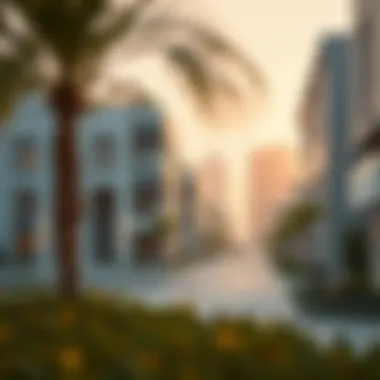
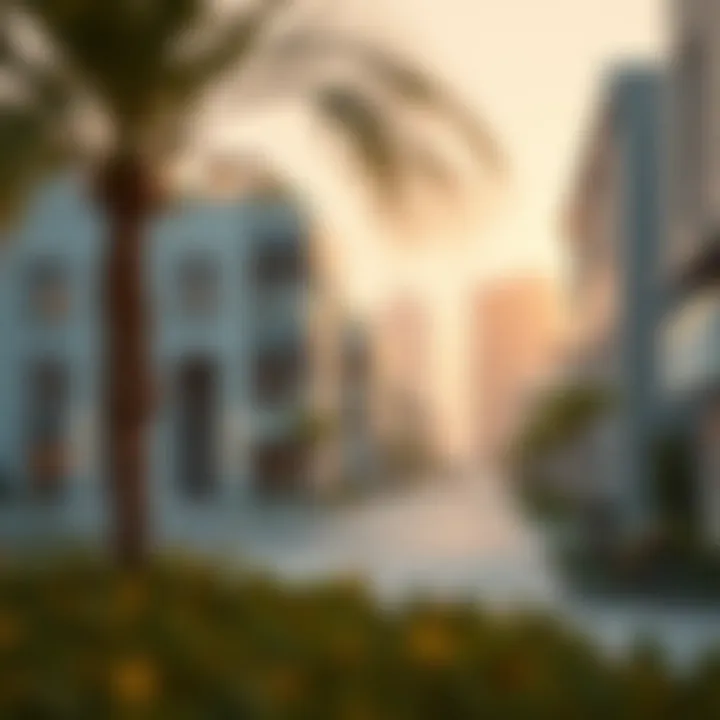
Challenges in Sustainable Housing Development
The growth of sustainable housing in Dubai represents a fundamental shift in how real estate is approached. Yet, this transition is not without hurdles. Understanding the challenges that developers face in sustainable housing is crucial for stakeholders—including investors, homebuyers, agents, and analysts—to navigate this evolving market effectively.
Cost Implications
Building sustainable homes often comes at a price. While the long-term benefits are evident, the upfront costs can deter developers, especially in a competitive market like Dubai's.
- Higher Initial Investment: Opting for eco-friendly materials or advanced energy-efficient technologies tends to inflate construction expenses. For example, solar panels or sustainable insulation can double the cost compared to standard materials. This can make home pricing less competitive, causing potential buyers to balk at the prices.
- Financing Obstacles: Banks and financial institutions may lack adequate financial products tailored for green buildings. This lack of specialized funding options can delay projects and deter environmentally-conscious investors.
- Risk of Longer ROI: Developers often grapple with extended return on investment (ROI) periods. The expected benefits, such as reduced utility bills and increased property value, might take years to materialize. This can instill hesitation among traditional investors looking for immediate returns.
Public Awareness and Education
Effective communication about the advantages of sustainable housing is equally critical. Despite the surge in popularity, a general lack of awareness can hinder progress toward developing these homes.
- Understanding Sustainability: The diverse components of sustainable living aren't always clear to the average consumer. Many potential buyers or investors may not fully grasp the benefits of features like rainwater harvesting systems or greywater recycling.
- Engagement through Education: Training programs and workshops concentrating on the importance of sustainable housing could foster greater public interest. For example, exhibitions or community seminars led by architects involved in sustainable projects can make a significant difference in how sustainability is perceived.
- Informed Decision-Making: Education fosters informed choices. If buyers understand the long-term savings associated with energy-efficient homes, they may be more willing to invest notwithstanding higher initial costs. Resources like Wikipedia on Sustainable Architecture can provide valuable insights into sustainable practices and technologies.
"Investing in sustainable housing might cost a pretty penny now, but it can save you a small fortune down the road."
The challenges are real, but they are not insurmountable. By addressing cost barriers and bolstering public awareness, Dubai's sustainable housing market can thrive, benefiting investors and enhancing community well-being.
Community and Social Aspects
The rise of sustainable houses in Dubai is not just about the physical structures or eco-friendly materials; it delves into the very fabric of community and the society at large. Understanding the community and social aspects is crucial for both investors and homebuyers who want to grasp the impact of these developments on overall well-being and value. By fostering an environment that prioritizes sustainability, developers not only improve property aesthetics but also enhance the quality of life for residents.
Building Sustainable Communities
Building a sustainable community in Dubai involves much more than erecting green buildings. It requires a holistic approach that encourages interaction, cohesive living, and an investment in local culture. Community design should focus on creating inclusive spaces where individuals from diverse backgrounds can come together. Here are some important considerations:
- Mixed-Use Development: Encouraging a blend of residential, commercial, and recreational spaces allows communities to thrive, giving residents easy access to services and leisure activities.
- Public Transportation Integration: To minimize reliance on personal vehicles, sustainable communities should prioritize efficient public transport, thereby reducing carbon footprints and enhancing accessibility.
- Green Spaces: Parks and natural areas serve as vital social hubs, providing residents with areas to gather, socialize, and enjoy nature. This promotes physical well-being and enhances environmental awareness.
Creating vibrant communities that foster social bonds will not only retain residents but also attract future buyers looking for lifestyle enrichment.
Responsibility Towards Future Generations
As we carve out this new landscape of sustainable living, the onus falls on us to ensure that short-term decisions do not jeopardize the long-term health of our communities or the environment. Emphasizing responsibility towards future generations is fundamental. Here are key points to consider:
- Educational Initiatives: Communities should invest in programs aimed at raising awareness about sustainability, such as workshops and seminars focusing on energy conservation and waste management. When children grow up with these values, they will likely carry them into adulthood.
- Resilience Planning: It's imperative to think long-term. Building homes that can withstand climate-related challenges while embracing renewable energies ensures that community members are safeguarded against future uncertainties.
- Civic Engagement: Encouraging residents to participate in local governance and decision-making processes can empower them and cultivate a sense of ownership. This investment can lead to more thoughtful and sustainable policies that reflect the needs of the community.
"Sustainability is not a destination; it's a continuous journey that requires every individual's involvement to ensure a better future for those who come after us."
In the bustling and rapidly evolving environment of Dubai, the path to sustainability will depend largely on how well communities can adapt and grow. By emphasizing community integration and a commitment to future generations, Dubai's real estate landscape can transform into a beacon of sustainable living, drawing interest from an ever-demanding, environmentally conscious global market.
The End
The landscape of sustainable housing in Dubai offers a glimpse into the future of living. It reflects a crucial intersection between environmental responsibility and real estate development. The importance of sustainable housing cannot be overstated, particularly in a rapidly developing city like Dubai, where the pressures of urbanization often clash with ecological considerations. As a pivotal chapter in this article, the conclusion serves to reinforce the necessity of integrating sustainability into everyday life.
The Future of Sustainable Housing in Dubai
The future holds immense promise for sustainable housing in Dubai. With the government's active encouragement and the increasing demand from a savvy populace, developers are compelled to rethink traditional strategies. This shift is about much more than compliance; it's a chance to innovate and set new standards.
- Emerging Architectural Styles: We are likely to witness the integration of more green architecture, where buildings are designed to harmonize with nature rather than dominate it. Solar panels and green roofs could become commonplace, reshaping the skyline.
- Technological Integration: The rise of smart technologies means homes can use energy more efficiently. Imagine a house that can adjust its temperature based on weather forecasts or notify its owner of water leaks instantaneously.
- Community-Centric Approaches: Future developments will likely foster a sense of community, emphasizing collaboration among residents. Parks, shared gardens, and communal facilities can be central to such neighborhoods, promoting social interaction.
"Sustainability in housing is not just an option anymore; it’s becoming a necessity for a better future."
Investors, who once focused solely on financial returns, are now drawn to the social implications of their investments. Homes designed with sustainability in mind can appreciate in value as they meet the increasing demands of eco-conscious buyers.
Public awareness around sustainable living is also rising. Homebuyers are more informed and are seeking properties that not only serve their needs but also uphold environmental standards.
As we venture further into this decade, Dubai's real estate landscape could very well become the benchmark for other urban centers looking to balance modernity with sustainability. Homeowners, investors, and developers alike must recognize that embracing sustainable practices benefits not just individuals but society at large.
The path towards a sustainable future is fraught with challenges, yet the rewards—both tangible and intangible—are profound. Through concerted efforts, Dubai could emerge as a beacon of sustainability, sheerly demonstrating that growth can indeed occur alongside respect and care for the environment.











